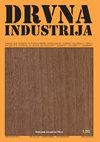Regional Clusters, Similarities, and Changes in Turkey’s Wood Production
IF 0.8
4区 农林科学
Q4 MATERIALS SCIENCE, PAPER & WOOD
引用次数: 2
Abstract
This study aimed to separate the wood production in regions and provinces of Turkey into homogeneous groups based on similarities by using the country’s wood production figures for 2013 and 2018. Within this context, the hierarchical Ward’s and non-hierarchical K-means clustering methods were used comparatively. Clustering analyses of 2 to 6 in number were performed via both methods, and the same regions mostly fell into the same cluster groups, although in different cluster combinations. The results showed that some provinces with rich forest areas did not produce enough wood. It was observed that these provinces were in the same clusters with provinces having a low amount of forest areas and low wood production. Over the five-year period, very few provinces and regions differed in line with the previous development plans. The creation of a spatial database for wood raw material production using the findings obtained in this study will contribute to the development of operational inventory methods that can be included in long- and medium-term forestry plans.土耳其木材生产的区域集群、相似性和变化
本研究旨在通过使用该国2013年和2018年的木材生产数据,根据相似性将土耳其地区和省份的木材生产分为同质组。在这种情况下,比较使用了分层Ward 's和非分层K-means聚类方法。两种方法的聚类分析数量为2 ~ 6,相同的区域虽然在不同的聚类组合中,但大多属于相同的聚类组。结果表明,一些森林资源丰富的省份木材产量不足。研究发现,这些省份与森林面积少、木材产量低的省份处于同一集群。在这五年期间,很少有省份和地区与以前的发展计划不一致。利用这项研究所得的结果为木材原料生产建立一个空间数据库,将有助于制订可列入长期和中期林业计划的业务盘存方法。
本文章由计算机程序翻译,如有差异,请以英文原文为准。
求助全文
约1分钟内获得全文
求助全文
来源期刊

Drvna Industrija
MATERIALS SCIENCE, PAPER & WOOD-
CiteScore
1.80
自引率
9.10%
发文量
32
审稿时长
>12 weeks
期刊介绍:
"Drvna industrija" ("Wood Industry") journal publishes original scientific and review papers, short notes, professional papers, conference papers, reports, professional information, bibliographical and survey articles and general notes relating to the forestry exploitation, biology, chemistry, physics and technology of wood, pulp and paper and wood components, including production, management and marketing aspects in the woodworking industry.
 求助内容:
求助内容: 应助结果提醒方式:
应助结果提醒方式:


